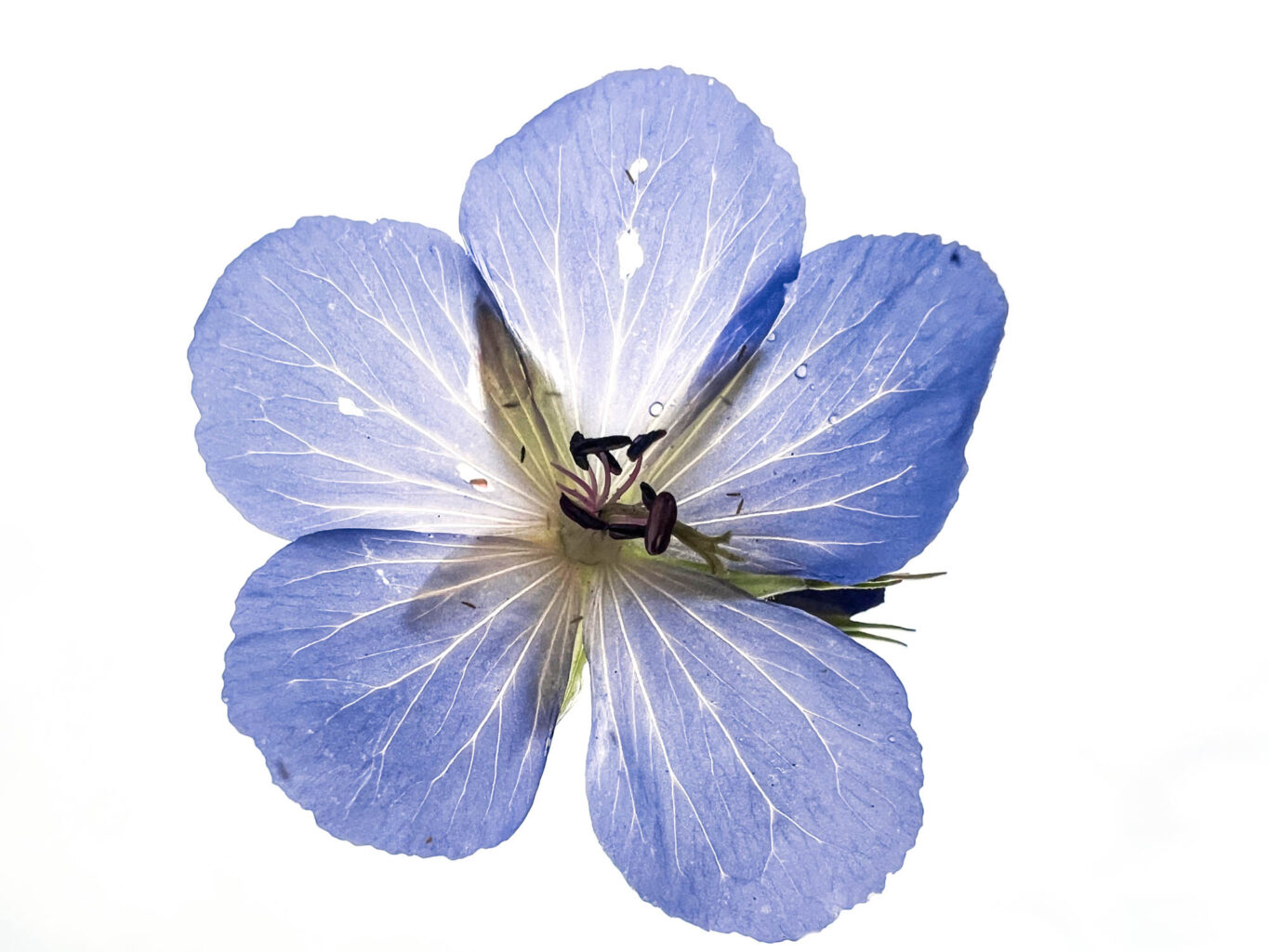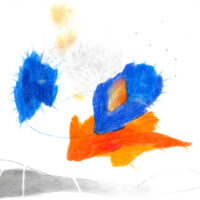Novalis’ poetry and prose reveal a master of inner development. His entire inner life was directed towards the blue flower, Sophia, as the ideal of soul development. Here, we share a special glimpse of the inner journey that Novalis underwent and communicated.
The maturity and wisdom found in the writings of young Novalis is surprising. However, individual statements about his inner path towards recognising his “most own self” are scattered and must be strung together like pearls to form a continuous strand.
The first step on this path is marked by his statement that we must give our undivided attention to everything we undertake, for “it is most remarkable that it is only in this play that the human being becomes aware of their distinctiveness, their specific freedom, and that it seems to them as if they were awakening from a deep sleep, as if they were only now at home in the world, and that only now is the light of day spreading over their inner world.”1 In this way, Novalis addresses a mental attitude many people aspire to today.
Mindfulness, Attentiveness, and Devotion
Through the Buddhist monk Thích Nhất Hạnh, broad swathes of Western society have become familiar with the term “Satipatthana,” which describes the basis of a conscious life. This attitude of mind is the epitome of the Buddhist doctrine of salvation, so much so that Buddha described it as the only path leading to purification of the mind and redemption.
The term “sati” from the Pali texts is translated into English as “mindfulness.” “Sati” is related to the verb “sarati,” “to remember,” which means that even events long past can still be present for a person who has developed the inner attitude of sati.
Many contemporary Westerners attracted to this attitude of mind refer to Jon Kabat-Zinn, a US-American considered the founder of the modern “mindfulness teaching,” which relates to this Buddhist doctrine. He defines mindfulness as “the consciousness that arises through directed, non-judgmental attentiveness in the present moment.”2
The differentiation between mindfulness and attentiveness is of great importance for the process of expanding consciousness, as these two terms are often equated but are different in quality. While we use the term “attentiveness” to indicate a more active process of directed awareness, “mindfulness” resonates with a more passive, devoted attitude of consciousness. In practice, however, this is often not sufficiently taken into account. Since mindfulness and attentiveness are not appropriately differentiated, there is a danger that the increased effort required for the mental attitude of attentiveness, which is necessary first, is bypassed on the path of development, preempted by the more passive attitude of mindfulness. This can then lead to the person drifting dreamily into the immediate events of everyday life.
There will be a tendency to remain in this undifferentiated state in which the “spirit’s power of attentiveness” and the “soul’s faculty of devotion” are differently developed instead of harmoniously complementing each other.
The result of this misunderstanding is that people who have practised mindfulness for years are not able to hold past events in mind. This is because memory is formed more through attentiveness and less through the inner attitude of general mindfulness. This connection is confirmed by Rudolf Steiner: “And the greater the ‘attentiveness,’ the easier it is for the soul to carry the sensory experiences along as memory conceptions in the further course of life.”3
Fundamentally, in every soul, forces of antipathy work as a prerequisite for “attentiveness” and forces of sympathy as a prerequisite for “devotion,” giving our life direction like a magnet. When antipathy, i.e., distancing from life, is predominant, our attitude of soul tends to be one of “attentiveness,” whereas when sympathy is predominant, “devotion” comes to the fore. Antipathy carries the danger of hardening, while excessive sympathy can lead to losing ourselves in the flow of what is happening in the moment. This can happen especially when, in accordance with the teachings of mindfulness, we understand the moment itself as the only reality.

The Buddha’s instruction to turn only towards the present—since what has been is past, and what is to come is not yet—must not be understood in absolute terms. Rather, this expresses his wisdom of accommodating the linear-thinking mind, on the one hand and counteracting the restless conceptual life that jumps around in time, on the other. A broader view of time, however, shows us that the moment emerges from the contact of what has been with what will come into being. The past pushes forward through the power of decisions made, while that which will come into being acts in a guiding way through the nascent power of the idea.
For spiritual development, it is necessary to practise both attitudes of the soul—the one of attentiveness and the one of devotion, that are summarised in the concept of mindfulness—separately at first in order to balance and overcome individual predispositions. Rudolf Steiner describes the necessity of understanding this as follows: “However, the two exercises—the one with attentiveness and the one with devotion—must be done separately because they contradict each other. If attentiveness requires the greatest exertion, concentrating on an object—that is to say, deepened meditation—devotion requires passive surrender to the flow of existence, an immeasurable heightening of that feeling which we find in religious experience or in other forms of devotion to a beloved being. The fruits that the human being derives from such an immeasurable increase of devotion and attentiveness are precisely that they separate their soul and spiritual life from that of the physical body.”4
The essence of any spiritual development is the detachment from identification with our physical existence and the personality anchored in it. Even if we walk many paths and strive for many good qualities, we will not experience the inherent freedom of the soul if we do not overcome this centredness on the I. An attentive attitude requires constant effort to make progress, even in relation to supposedly insignificant things like placing our foot or reaching for an object. As we continue to learn to understand the motivations for our thoughts, feelings, and actions, this gradually leads us to objectify ourselves. In the growing certainty about our freedom, we begin to responsibly look after the inner and outer “place” given to us. Expansiveness and stillness take hold of us in conscious existence so that we can surrender ourselves, full of trust, to the wisdom at work in life. We no longer need to search for a better, distant land because we have realised that this search is really only an expression of our restlessness.
Knowing these connections, Novalis calls the second step “devotion” to the world: “The first step will be looking inwards, the separating contemplation of our self. Whoever stops here only gets halfway. The second step must be the effective look outwards, the sustained observation of the outside world by our own activity.”5
Through the awakening of our conscious relationship with the world, a harmonious soul life unfolds, and most people will aspire to nothing more. Those, however, who perceive an inner longing, what we might call a memory of our spiritual origin, will seek to take further steps.
Philosophy
“I long to behold the blue flower. It is incessantly on my mind, and I can think and write of nothing else,”6 says Novalis, specifying the development of “attentiveness” and “devotion” as the first two steps of the inner development that led him to the fulfillment of his longing.
Before birth, we gave ourselves our own individual path in the process of incarnation by forming soul characteristics for our personality from the potential of humanity in accordance with our path of destiny. At first, forces of antipathy and sympathy lead us through life unconsciously. Through conscious work, we eventually transform these into the “spirit’s power of attentiveness” and the “soul’s faculty of devotion,” which, we might say, form the basis of every spiritual endeavour as new organs of perception. Through attentiveness, we purify our person in order to be able to devote ourselves to the world with “pure sight.”
In a letter to Friedrich Schlegel, Novalis calls this path “philosophy”: “My favourite study is basically called like my bride: Sophia is her name—philosophy is the soul of my life and the key to my most own self.”7
Novalis’ understanding of philosophy is that it is an act of direct transformation of the soul, which he divides into three stages of consciousness:8
- “Wakefulness”
- “Being awake”
- “Consciousness.”
At the first stage of “wakefulness,” in which we train our attentiveness, we identify our I with the physical body that we have built up from the elements of the earth and will one day give back. However, we “have” a body but “are” not the body. We experience “wakefulness” essentially through our polar relationship of inner and outer world. However, in order to recognise the “one” life that reveals itself in both poles at the same time, we have to overcome this exclusively polar experience. Alexander von Humboldt describes this process in a letter to Caroline von Wolzogen, in which he reports how he realised, deep in his soul, that from “pole to pole, only one life is poured out in stones, plants, and animals and in the human being’s swelling breast. Everywhere, I was permeated by the feeling of how powerfully those circumstances in Jena had affected me, how I, uplifted by Goethe’s views of nature, had been equipped, as it were, with new organs.”9
If we shine a light on the impulses of our thinking, feeling, and willing through the power of “attentiveness,” then, over time, self-reference dissolves, and the ability for devotion unfolds, expanding our consciousness beyond the body. A “space of the I” arises around us in which the various motivations with which we had previously identified now take place. If this “space” becomes our nature, the transition from “wakefulness” to “being awake” to the state of mind of “mindfulness” takes place. In it, attentiveness and devotion complement each other harmoniously, as Novalis states: “He believes he has attained the highest level when he can […] at the same time carry out the ordinary business of the senses, and feel and think at the same time. It is thus a gain for both perceptions: the outer world becomes transparent, and the inner world manifold and full of meaning, and thus human beings find themselves in an intimately living state between two worlds in the most perfect freedom and the most joyful sense of power.”10

The etheric body, which encompasses and permeates the physical body, begins to detach itself from the latter, something that is associated with the feeling of gradually expanding beyond it. The boundaries between inside and outside become more fluid, and there arises not only the sensation of connectedness with the surrounding space but the intuitive perception that everything is contained within the I. This process of expansion happens gradually. If attentiveness and devotion are the prerequisites for the development of “mindfulness,” then mindfulness, in turn, is the prerequisite for realising the next stage, that of “conscious existence,” which Novalis seeks to experience in the longing for Sophia.
However, in order to move from the second level of “being awake” to the third level of “conscious existence,” grace is required, for this level of our being cannot be reached through conscious volition. We can develop as far as the second stage out of the I, but in order to realise the sphere of “conscious existence,” the inner effort must pass over into the soul faculty of consciously intensified “devotion.” The step from “being awake” to “conscious existence” through the soul faculty of “devotion” does not proceed gradually, like the transition from “wakefulness” to “being awake”—it occurs suddenly, as the I-centredness in the head dissolves, and we find ourselves at the base of our corporeality, of a “tower”: in the pelvis. This is how the “baptism with water” takes place, depicted in mystical writings in the image of the marriage of king and queen in a basin of water. The harmonisation of the polar soul forces occurs. When this initiation is accomplished, the crown of the head opens, through which the soul overcomes corporeality as if in one leap.
Novalis describes this experience in his Spiritual Songs with the following words:
As thus in silence I sickened,
Ever weeping and longing to be gone,
Only remaining because of fear and delusion:
Suddenly, as if from above,
The grave’s stone was lifted,
And my inwardness thrown open.
The soul detaches itself from the physical body, and the etheric body associated with it, through the portal of the head and blossoms into a sphere of incorporeality, into “conscious existence,” a blue sea suffused with the sparkle of stars, like a “blue flower.” The purified astral body is thus pure “conscious existence,” pure wisdom-filled spirit, which becomes intuitively aware of itself and forms the basis for the perceptual faculty of all beings. In Christian spirituality, it is called the “cosmic, wise, virgin Sophia,” whom Novalis strives to find through the three stages of philosophy and longs for in the image of the blue flower. The realisation also shines forth that it takes just such purity to give birth to a higher human being within us. This is why the mother of Jesus, the “Virgin Mary,” is an image, on the physical level, of the “Cosmic Virgin Sophia” and is depicted in many pictures with a blue cloak studded with stars and twelve stars arranged around her head.
From this experience, we can share Novalis’ feeling:
I see you in a thousand pictures,
Mary, so tenderly expressed,
But none of them can portray you
As my soul beholds you.
I only know that the world’s turmoil
Has since then vanished like a dream,
And an unutterably sweet heaven
Forever in my mind resides.
Gratitude
At this moment of spiritual development, it is crucial to correctly classify what has been experienced. Even if “conscious existence” becomes aware of itself as pure spirit, this does not correspond to the sphere of the “Spirit-Self” or “Holy Spirit” described by Rudolf Steiner. Some people may be tempted at this point to believe that they have reached the goal of spiritual development. However, a soul filled with deeper longing experiences something sobering instead. In Christian spirituality, it is the encounter with Christ as the “Greater Guardian of the Threshold” that is possible on this level, which allows us to recognise who we really are and who we can become, if we follow His example and turn to earth like He once did from the heavenly worlds, since we can only develop love on earth in union with Christ.
If we do not selfishly preserve this level of the “blue flower,” the “cosmic Sophia,” we will be able to take the next developmental step with Novalis: “Just look out for a little blue flower, which you will find up here, break it off, and then humbly entrust yourself to heavenly guidance.”11 Great affirmation and gratitude towards life will then fill our soul, opening up new dimensions of existence for us. This inner attitude of gratitude is described by Rudolf Steiner as follows: “It is the most beautiful way to be guided from our personality to the supersensory when this guidance passes through gratitude, through gratitude towards life. This gratitude is also a path into the supersensory, and it ultimately ends up in veneration and love for the life-giving spirit of the human being. Gratitude gives birth to love. Love, then, when it is born of gratitude for life, gives birth to unlocking the heart to the spiritual powers that permeate life.”12
For Novalis, Philo-“Sophie” is the soul of his life and the key to his “most own self.” Thus, the “purified conscious existence” of the cosmic Sophia descends into the chest area and erects the altar at which the sacred fire of the heart is kindled so that Novalis can state, “We are occupied with nothing but maintaining a sacred and mysterious flame.”13 Through this mysterious flame burning in the heart, Novalis finds the gateway to Christ, the “self” that dwells in every human being as the “Christ I.” When we take hold of the pure, wisdom-filled spirit of the “cosmic virgin Sophia” with this “self,” it becomes the “spirit-self,” the “Holy Spirit.”
Durch diese geheimnisvolle, im Herzen brennende Flamme findet Novalis das Tor zum Christus, dem ‹Selbst›, das jedem Menschen als ‹Christus-Ich› innewohnt. Wenn wir mit diesem unserem ‹Selbst› den reinen weisheitsvollen Geist der ‹Kosmischen Jungfrau Sophia› ergreifen, wird er zum ‹Geistselbst›, dem ‹Heiligen Geist›.
Books by Zoran Perowanowitsch are published (in German) by Kitesh.
Translation Christian von Arnim
Photos Sofia Lismont
Footnotes
- Richard Samuel, Novalis Edition, Vol. 1. Stuttgart 1981, p. 97.
- Jon Kabat-Zinn, Gesund durch Meditation (Health through Meditation). Munich 2013, p. 23.
- GA 115, p.160.
- GA 153, p. 20ff.
- Novalis, Fragmentensammlung (Collection of Fragments), Blüthenstaub, No. 24.
- Novalis, Heinrich von Ofterdingen. Reinbeck 1963, p. 90.
- Richard Samuel, Novalis Edition, Vol. 4. Stuttgart 1975, p. 188.
- Richard Samuel, Novalis Edition, Vol. 3. Stuttgart 1983, p. 572.
- Alexander von Humboldt, Aus meinem Leben (From My Life). Munich 1989, p. 180.
- Richard Samuel, Novalis Edition, Vol. 1. Stuttgart 1981, p. 97.
- Rowohlts Klassiker der Literatur und der Wissenschaften (Rohwohlt’s Classics of Literature and Science), Vol. 11, Ed. Ernesto Grassi, Hamburg 1963, p. 96.
- GA 239, p. 224.
- Richard Samuel, Novalis Edition, Vol. 3. Stuttgart 1983, p. 608.






Excellent article. Now to apply it.
First time I used this space.
Thank you